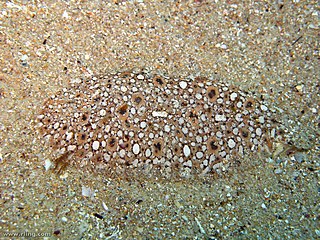
Epinephelus is a genus of marine ray-finned fish, groupers from the subfamily Epinephelinae, part of the family Serranidae, which also includes the anthias and sea basses. They are predatory fish, largely associated with reefs and are found in tropical and subtropical seas throughout the world. They are important target species for fisheries.

Naso is a genus of fish in the surgeonfish family, Acanthuridae. Fish of this genus are known commonly as unicornfishes because of the "rostral protuberance", a hornlike extension of the forehead present in some species. Unicorn fish are popular with spearfishermen and may be cooked by grilling them whole. Unicornfish primarily live around coral reefs and eat mostly algae as well as roshi (flour) in Maldives. It's very popular in Maldives.

Clingfishes are fishes of the family Gobiesocidae, the only family in the order Gobiesociformes. These fairly small to very small fishes are widespread in tropical and temperate regions, mostly near the coast, but a few species in deeper seas or fresh water. Most species shelter in shallow reefs or seagrass beds, clinging to rocks, algae and seagrass leaves with their sucking disc, a structure on their chest.

Canthigaster is a genus in the pufferfish family (Tetraodontidae). A fish from this genus is sometimes referred to as a "toby" or a "sharpnose puffer".

Pseudanthias is a genus of colourful reef fishes of the subfamily Anthiinae, part of the family Serranidae, the groupers and sea basses. They are found in the Indo-Pacific. The species belonging to this genus have a diet consisting of zooplankton, and are haremic. Fishes currently included in this genus were earlier part of the genus Anthias. Pseudanthias is the largest anthiine genus

Diademichthys lineatus, commonly known as the long-snout clingfish or urchin clingfish, is a species of marine fish in the family Gobiesocidae.

Bryaninops is a tropical Indo-Pacific genus of gobies. The genus takes its common name from the fact that it is commensal on gorgonians and black coral. The genus is further characterised by cryptic colouration.

Albula is a genus of fish belonging to the bonefish family Albulidae.

The gardens eel are the subfamily Heterochongrinae in the conger eel family Congridae. The majority of garden eels live in the Indo-Pacific, but species are also found in warmer parts of the Atlantic Ocean and East Pacific. These small eels live in burrows on the sea floor and get their name from their practice of poking their heads from their burrows while most of their bodies remain hidden. Since they tend to live in groups, the many eel heads "growing" from the sea floor resemble the plants in a garden. They vary greatly in colour depending on the exact species involved. The largest species reaches about 120 cm (47 in) in length, but most species do not surpass 60 cm (24 in). Garden eel colonies can grow as large as one acre in surface area.

Odontanthias is a genus of marine ray-finned fish in the subfamily Anthiinae and family Serranidae. Depending on the exact species, they reach up to 10–22 cm (3.9–8.7 in) in standard length, and are brightly marked with pink and yellow. They are found at rocky reefs in deep water, mainly below 100 m (330 ft). The genus is almost entirely restricted to the Indo-Pacific; O. cauoh of the Saint Peter and Saint Paul Archipelago and O. hensleyi of the Caribbean are the only species known from outside the Indo-Pacific and evidence indicates that the latter belongs in Anthias.
Briggsia hastingsi is a species of clingfish so far only known from Rahah Bay, Oman. This species grows to a length of 2.2 centimetres (0.87 in) SL. This species is the only known member of its genus. It was described in 2009 from the only known specimen by Matthew T. Craig and John E. Randall. The generic name honours the clingfish systematicist John Carmon Briggs (1920-2018) of the Georgia Museum of Natural History while the specific name honours Philip A. Hastings of the Scripps Institute of Oceanography, who was the PhD supervisor of Matthew T. Craig and who sparked his interest in clingfishes.

Lepadichthys is a genus of clingfishes native to the Indian and Pacific Oceans.

Pherallodus is an Indo-Pacific genus of clingfishes from the family Gobiesocidae.

Pardachirus is a genus of soles mainly native to coastal water in the Indo-Pacific. A single species, P. poropterus is restricted to estuaries and lower sections of freshwater streams. At least some species in the genus are toxic.

Solea is a genus of soles from the Indo-Pacific and East Atlantic Oceans, and the Mediterranean Sea.
Gnatholepis is a genus of fish in the family Gobiidae, the gobies. It is the only marine genus in the subfamily Gobionellinae, which otherwise includes mostly estuary-dwelling and freshwater fish. Gnatholepis are tropical fish associated with sandy habitat around corals.

Pseudocoris is a genus of wrasses native to the eastern Indian Ocean and the western Pacific Ocean.
John Ernest "Jack" Randall was an American ichthyologist and a leading authority on coral reef fishes. Randall described over 800 species and authored 11 books and over 900 scientific papers and popular articles. He spent most of his career working in Hawaii. He died in April 2020 at the age of 95.

Lepadichthys lineatus, also known as the twoline clingfish, doubleline clingfish or doublestripe feather star clingfish, is a small clingfish which lives among the arms of crinoids. This species has an Indo-Pacific distribution from the Red Sea to Fiji, however, this is scattered rather than continuous and it has been recorded off Mozambique, the Seychelles, Sri Lanka, Myanmar, Philippines, Papaua New Guinea, the Marianas, Japan and Fiji.
Unguitrema nigrum, also known as the Black crinoid clingfish is a species of clingfish endemic to Papua New Guinea. This species occurs Madang Lagoon in Madang District, Madang Province, Papua New Guinea. This species is the only known member of its genus. It was collected from a crinoid, Oxycomanthus bennetti, of the black phase.
















